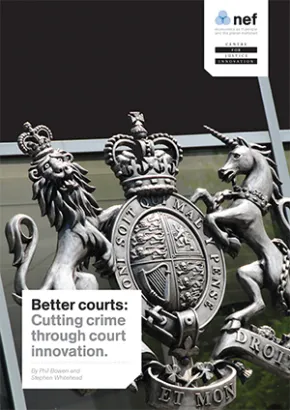While our criminal courts are known worldwide for their neutrality and even-handedness, there is more that they can do to reduce reoffending. This report sets out 11 practical examples of how courts can cut crime by innovating to become faster, more authoritative, more people focussed, and to feel fairer. These examples are driven by two evidence-based models: problem-solving and procedural fairness.
Problem-solving courts put judges at the centre of rehabilitation. Based in existing court buildings, problem-solving courts yoke together the authority of the court and the services necessary to reduce reoffending and improve outcomes. There are wide variety of problem-solving models, each with their own particular specialism, including drug courts, domestic violence courts and community courts. Evidence has shown that, when used in the right way, problem-solving courts can cut costs and reduce reoffending.
When courts act with fairness, people are more likely to respect the law. But that means not just being fair but being seen to be fair. By appearing, respectful, neutral and helping people understand and have a voice, courts can encourage members of the public to obey court orders, co-operate with the police and ultimately not commit crime.
Problem-solving courts in practice
There are many different kinds of problem-solving courts, because each one specialises in a particular issue, type of crime, group of defendants or area. Some of the most common kinds are:
- Drug courts such as the Glasgow Drug Court focus on working with people whose offending is driven by drug addiction. They sentence people to drug treatment and bring them back before the court regularly to review their progress. Evidence shows that drug courts reduce reoffending and help people overcome addiction.
- Domestic violence courts focus on keeping victims safe and prosecuting perpetrators. In England and Wales our domestic violence courts have specially trained staff to support victims. In other countries they also monitor perpetrators in the community to ensure they comply with the orders of the court. Evidence shows that they can reduce reoffending and make victims feel safer.
- Community courts like New York’s Red Hook Community Justice Centre focus on crime in a specific neighbourhood, working with police and the community to address local issues. They can sentence low level offenders to support like education and training or drug treatment. Evidence shows they reduce reoffending and improve public confidence.
Treating people fairly
Research has shown that there are four things courts must do to make sure people feel fairly treated:
- Ensure that members of the public understand the way the court works by avoiding jargon and taking the time to explain complex processes
- Show respect for members of the public through simple gestures like greeting them by name and making eye contact.
- Appear neutral by ensuring that courts staff are not too friendly with prosecutors or deferential to police officers giving evidence.
- Give all parties a voice, by making sure they have the opportunity to share their side of the story.
